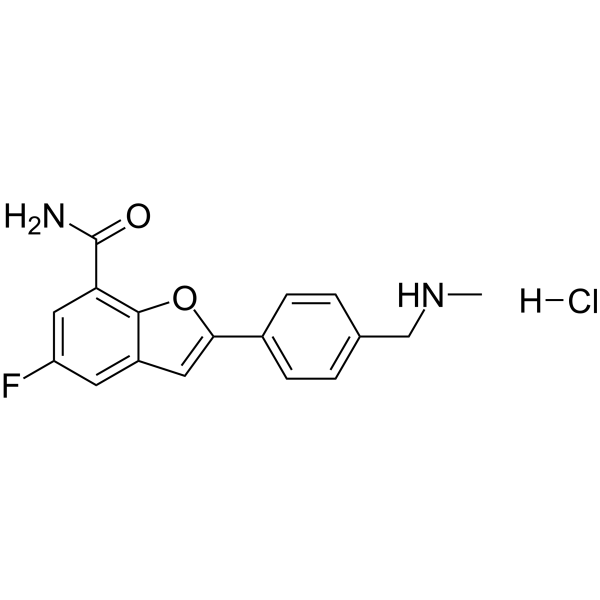上海金畔生物科技有限公司为生命科学和医药研发人员提供生物活性分子抑制剂、激动剂、特异性抑制剂、化合物库、重组蛋白,专注于信号通路和疾病研究领域。
Mefuparib hydrochloride (Synonyms: MPH) 纯度: 98.94%
Mefuparib hydrochloride (MPH) 是一种具有口服活性的,底物竞争性和选择性的 PARP1/2 抑制剂,IC50 分别为 3.2 nM 和 1.9 nM。Mefuparib hydrochloride 诱导细胞凋亡 (apoptosis),并在体内外具有显着的抗癌活性。

Mefuparib hydrochloride Chemical Structure
CAS No. : 1449746-00-2
| 规格 | 价格 | 是否有货 | 数量 |
|---|---|---|---|
| 5 mg | ¥2000 | In-stock | |
| 10 mg | ¥3500 | In-stock | |
| 25 mg | ¥7000 | In-stock | |
| 50 mg | 询价 | ||
| 100 mg | 询价 |
* Please select Quantity before adding items.
Mefuparib hydrochloride 相关产品
•相关化合物库:
- Drug Repurposing Compound Library Plus
- Clinical Compound Library Plus
- Bioactive Compound Library Plus
- Apoptosis Compound Library
- Cell Cycle/DNA Damage Compound Library
- Epigenetics Compound Library
- Anti-Cancer Compound Library
- Clinical Compound Library
- Anti-Aging Compound Library
- Drug Repurposing Compound Library
- Anti-Breast Cancer Compound Library
- Anti-Pancreatic Cancer Compound Library
- Children’s Drug Library
| 生物活性 |
Mefuparib hydrochloride (MPH) is an orally active, substrate-competitive and selective PARP1/2 inhibitor with IC50s of 3.2 nM and 1.9 nM, respectively. Mefuparib hydrochloride induces apoptosis and possesses prominent anticancer activity in vitro and in vivo[1][2]. |
||||||||||||||||||||||||
|---|---|---|---|---|---|---|---|---|---|---|---|---|---|---|---|---|---|---|---|---|---|---|---|---|---|
| IC50 & Target[1] |
|
||||||||||||||||||||||||
| 体外研究 (In Vitro) |
Mefuparib hydrochloride (1-10 μM; 48 hours) causes cell apoptosis[1]. 上海金畔生物科技有限公司 has not independently confirmed the accuracy of these methods. They are for reference only. Apoptosis Analysis[1]
Cell Cycle Analysis[1]
Western Blot Analysis[1]
|
||||||||||||||||||||||||
| 体内研究 (In Vivo) |
Mefuparib hydrochloride (MPH; 40-160 mg/kg; orally; once every other day; for 21 days) displays dose- and time-dependent killing on V-C8 xenografts accompanied by complete disappearance of some xenografts, especially in the high-dose group[1]. 上海金畔生物科技有限公司 has not independently confirmed the accuracy of these methods. They are for reference only.
|
||||||||||||||||||||||||
| Clinical Trial |
|
||||||||||||||||||||||||
| 分子量 |
334.77 |
||||||||||||||||||||||||
| Formula |
C17H16ClFN2O2 |
||||||||||||||||||||||||
| CAS 号 |
1449746-00-2 |
||||||||||||||||||||||||
| 中文名称 |
盐酸美呋哌瑞 |
||||||||||||||||||||||||
| 运输条件 |
Room temperature in continental US; may vary elsewhere. |
||||||||||||||||||||||||
| 储存方式 |
4°C, sealed storage, away from moisture *In solvent : -80°C, 6 months; -20°C, 1 month (sealed storage, away from moisture) |
||||||||||||||||||||||||
| 溶解性数据 |
In Vitro:
DMSO : 25 mg/mL (74.68 mM; Need ultrasonic) 配制储备液
*
请根据产品在不同溶剂中的溶解度选择合适的溶剂配制储备液;一旦配成溶液,请分装保存,避免反复冻融造成的产品失效。 In Vivo:
请根据您的实验动物和给药方式选择适当的溶解方案。以下溶解方案都请先按照 In Vitro 方式配制澄清的储备液,再依次添加助溶剂: ——为保证实验结果的可靠性,澄清的储备液可以根据储存条件,适当保存;体内实验的工作液,建议您现用现配,当天使用; 以下溶剂前显示的百
|
||||||||||||||||||||||||
| 参考文献 |
|
所有产品仅用作科学研究或药证申报,我们不为任何个人用途提供产品和服务
